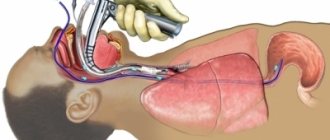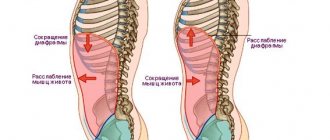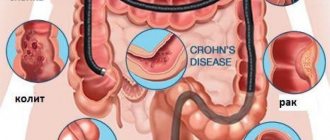What is abdominal pain
Abdominal pain is not an independent disease. The symptom manifests itself as pain in the abdominal area and indicates the development of pathologies of internal organs. This type of pain can be acute or chronic. Pain may be present constantly or occur periodically. Very often in the second case, the pain syndrome is paroxysmal in nature. In any case, abdominal pain requires urgent diagnosis.
Classification of abdominal pain
Abdominal pain is:
- Spicy
. In this case, they are called colic. Very often, such painful sensations manifest themselves in attacks of varying intensity. Pain may appear suddenly and disappear just as quickly. Their occurrence may be accompanied by nausea, vomiting, flatulence, and palpitations. - Chronic
. Painful sensations are present almost constantly. Patients often characterize this symptom as “burning in the stomach.”
Acute pain
Acute abdominal pain in medicine is included in the concept of “acute abdomen”. This is a very dangerous symptom that indicates serious damage to internal organs. Diseases such as appendicitis, cholecystitis and pancreatitis during exacerbation, perforated ulcers, etc. cause acute abdominal pain.
In addition, this sign may indicate the possibility of developing other pathological changes:
- obstruction of hollow organs, in particular, the development of intestinal obstruction;
- impaired organ perfusion due to thrombosis, stenosis and ruptures;
- stretching of the capsule of a certain organ, for example, due to acute alcoholic hepatitis or heart failure.
Chronic pain
Chronic pain indicates the presence of serious pathologies in the abdominal organs. This pain syndrome most often occurs against the background of irritable bowel syndrome.
Chronic abdominal pain is of low intensity, but due to the fact that it is constantly present, a person is exhausted, irritability and depression occur.
In addition, there are other types of abdominal pain:
- Peritoneal pain. They are characterized by a sudden onset, last a long time and subside slowly. By palpation, you can accurately detect their location. Pain increases with coughing and sneezing.
- Abdominal pain of a cutting and pulling nature. They occur against the background of stretching of the muscles of the internal organs. In such cases, it is very difficult to find the location of pain using palpation.
- Stenotic and angiospastic pain. They occur against the background of impaired local circulation. In the first case, the intensity of the pain gradually increases, and in the second, the pain is paroxysmal in nature.
Abdominal pain: mechanisms of formation, rational approach to the choice of therapy
About the article
28062
0
RMJ Appendix “Diseases of the Digestive Organs” No. 2 dated 01.09.2009 p. 48
Category: Digestive diseases
Authors: Yakovenko E.P. , Yakovenko A.V. , Agafonova N.A. , Ivanov A.N. , Pryanishnikova A.S. , Popova E.V. , Grigorieva Yu.V.
For quotation:
Yakovenko E.P., Yakovenko A.V., Agafonova N.A. and others. Abdominal pain: mechanisms of formation, rational approach to the choice of therapy. RMJ. 2009;2:48.
Abdominal pain is the leading symptom, indicating the presence of organic pathology and/or functional disorders of the digestive organs, requiring clarification of the mechanisms of their development and selection of effective therapy.
Pain is a subjective sensation that occurs as a result of impulses entering the central nervous system from the periphery (as opposed to soreness, which is determined during examination, for example, by palpation). Two types of receptors are involved in the formation of abdominal pain syndrome: visceral nociceptors and the endings of sensory nerve fibers, the irritation of which causes the formation of nociceptive or neuropathic pain, respectively. Visceral nociceptors, in turn, include three types of pain receptors: high-threshold mechanoreceptors, which respond only to a pronounced stimulus, in particular muscle spasm, “intensity” nociceptors, excited in response to weak stimuli, and silent nociceptors, which are activated in the presence of tissue damage. [5,14]. Pain receptors of the hollow organs of the abdominal cavity (esophagus, stomach, intestines, gallbladder, bile and pancreatic ducts) are localized in the muscular and serous membrane of their walls. Similar receptors are present in the capsule of parenchymal organs, such as the liver, kidneys, and spleen, and their stretching is accompanied by pain. The mesentery and parietal peritoneum also have sensitivity to painful stimuli, while the visceral peritoneum and greater omentum lack it. The abdominal organs are usually insensitive to many stimuli that, when applied to the skin, cause severe pain. At the same time, stretching and tension of the wall of the hollow organ irritate pain receptors. The reasons for the development of abdominal pain are diverse [9,14]. The etiological classification of abdominal pain is presented in Table 1. Abdominal pain is divided into acute, which usually develop quickly, less often - gradually and have a short duration (minutes, rarely several hours) and chronic, which persist or recur over weeks and months. Depending on the location and strength of the damaging factor, pain in the abdominal cavity is divided into visceral, parietal (somatic), reflected (radiating) and psychogenic [6,14]. Visceral pain occurs in the presence of pathological stimuli associated with the pathology of the abdominal organs and is carried out by sympathetic fibers. The main triggering factors for its occurrence are a rapid increase in pressure in the hollow organ and stretching of its wall (the most common cause), stretching of the capsule of parenchymal organs, tension of the mesentery, and vascular disorders. According to the mechanism of development, visceral pain can be conditionally divided into spastic, caused by spasm of the smooth muscles of the gastrointestinal tract (GIT), distensional, associated with hypomotor dyskinesia of smooth muscles and stretching of a hollow organ, peritoneal, which is based on the tension of the capsule or visceral layer of the peritoneum and vascular. Somatic pain is caused by the presence of pathological processes in the parietal peritoneum and tissues containing the endings of sensory spinal nerves and its occurrence is associated with pathological processes accompanied by damage to the abdominal wall and/or peritoneum. Differential diagnostic signs of visceral and somatic pain are presented in Table 2. Radiating pain is localized in various areas remote from the pathological focus. It occurs in cases where the impulse of visceral pain is excessively intense (for example, the passage of a stone) or when there is anatomical damage to an organ (for example, intestinal strangulation). Referring pain is transmitted to areas of the body surface that have common radicular innervation with the affected organ of the abdominal region. Psychogenic pain occurs in the absence of visceral or somatic causes, or the latter play the role of a trigger or predisposing factor. A special role in its occurrence belongs to depression, which often occurs hidden and is not recognized by the patients themselves. The close connection between depression and chronic abdominal pain is explained by general biochemical processes, and primarily by the insufficiency of monoaminergic (serotonergic) mechanisms. This is confirmed by the high effectiveness of antidepressants (especially serotonin reuptake inhibitors) in the treatment of this pain syndrome. The main signs of these pains are their duration, monotony, diffuse nature and combination with other localizations: headache, back pain, pain throughout the body [2]. One of the most common functional disorders, including in patients with organic pathology of the digestive organs, is spastic dyskinesia of smooth muscles, in which there is an increase in intraluminal pressure and a violation of the movement of contents through a hollow organ, which creates the preconditions for the occurrence of pain and dyspeptic disorders, such as constipation, flatulence, belching, heartburn, nausea, and less commonly, vomiting. In this case, the intensity of pain and the severity of dyspeptic disorders are proportional to the rate of increase and the height of pressure in the hollow organ. Among patients turning to a gastroenterologist, up to 50% have diseases whose symptoms are caused by hypermotor, and primarily spastic dyskinesia of the smooth muscles of the gastrointestinal tract. A classic example of clinical manifestations of spastic intestinal dyskinesia is IBS, and the biliary system is functional disorders of the gallbladder and sphincter of Oddi [8]. Irritable bowel syndrome (IBS) is a functional bowel disorder in which abdominal pain and symptoms of intestinal dyspepsia are not associated with structural changes in the intestinal wall, as well as metabolic or tumor processes. According to the Rome III Consensus (2006), diagnostic criteria for IBS include: the presence of recurrent abdominal pain or discomfort lasting at least 3 days per month during the last 3 months during the 6 months preceding diagnosis, in combination with the following symptoms (at least two): improvement after defecation; onset associated with changes in stool frequency; the beginning associated with a change in the shape (appearance) of feces. Symptoms that confirm the diagnosis, but are not part of the diagnostic criteria for IBS, include: impaired stool frequency - stool less than three times a week or more than 3 times a day; abnormal stool shape - hard or bean-shaped, liquefied or watery; straining during bowel movements or urgency of bowel movements or a feeling of incomplete bowel movement; mucus secretion; presence of bloating. According to the Rome III criteria, the following types of IBS are distinguished: 1. IBS with constipation - in the presence of hard or bean-shaped stool in >25% of the total number of bowel movements, but the presence of liquefied (mushy) or watery stool is also allowed in <25% of the total number of bowel movements intestines. 2. IBS with diarrhea, in which pasty or watery stool occurs in >25% of the total number of bowel movements, but the presence of hard or bean-shaped stool is also acceptable in <25% of the total number of bowel movements. 3. IBS of mixed type, in which there is an alternation of hard or bean-shaped stool and pasty or watery stool when
Classification of abdominal pain
There are functional and pathological causes of abdominal pain. The danger to health in general arises in the second case. For abdominal pain that depends on functional causes, treatment consists of eliminating the provoking factors.
Functional reasons
The most common cause of abdominal pain is a violation of the principles of healthy eating.
The following factors can trigger abdominal pain:
- Lack of fluid in the body.
- Passion for spicy, salty, fatty foods.
- A large amount of carbohydrate and gas-forming foods in the diet.
In addition, functional reasons include uncontrolled use of drugs that have a negative effect on the state of the digestive system. Also, abdominal pain during menstruation, pregnancy, and colic in children in infancy do not require special treatment.
Pathological causes
Pathological causes are associated with diseases or injuries of specific organs. They are conditionally divided by reason of their occurrence.
Painful sensations can be caused by:
- Inflammatory processes of certain organs.
- Ischemia.
- Obstruction of a duct or any hollow organ.
- Violation of the integrity of an organ or internal tissues.
- Oncological neoplasms.
Abdominal pain when taking medications
Abdominal pain is acute or chronic pain in the abdominal area, occurring periodically (paroxysmal) or occurring constantly.
The abdomen is bounded above by the costal arches and below by the pubic symphysis, so any discomfort in this region is regarded as abdominal pain syndrome. Abdominal pain is not an independent disease, but only a sign of some pathology of the abdominal cavity.
Classification
According to the mechanism of pain, there can be:
- Visceral (come from a hollow or parenchymal organ). They occur most often and are associated with mechanical damage, excessive stretching, inflammation or circulatory disorders of internal organs. They occur in both organic and functional conditions. Accompanied by symptoms of dysfunction (for example, nausea, vomiting, stool retention, bloating, increased body temperature), vegetative manifestations (fear, palpitations, dizziness, sweating, pallor).
- Parietal or somatic. They arise due to irritation of the peritoneum. In some cases, the involvement of the peritoneal layers in the inflammatory process occurs following the internal organ. The pain syndrome intensifies, becomes more distinct (localized), and acute.
- Irradiating. Referred pain sensations occur in areas of skin sensitivity, which are innervated by the same part of the spinal cord as the affected organ.
- Psychogenic pain occurs when the central mechanisms of pain sensitivity control are disrupted. In this case, no organic pathologies are observed in the abdominal cavity. Most often, such pain is constant, long-lasting, not acute, does not lead to sleep disturbances, and is accompanied by depression. These symptoms are usually not accompanied by disruption of the digestive tract: constipation, diarrhea, tension in the abdominal muscles.
According to the duration and nature of the pain, they are divided into:
- Spicy. Observed in case of vascular or other pathologies in the abdominal cavity (perforation of a stomach ulcer, thrombosis of mesenteric vessels, rupture of the spleen, intussusception, bleeding, etc.).
- Paroxysmal (periodic). Appears at certain intervals, lasting from several seconds to several hours. Characteristic of intestinal colic, biliary dyskinesia.
- Permanent (chronic). The patient is disturbed almost constantly, often of moderate intensity, dull. Observed with inflammation of the pancreas, chronic hepatitis, prolonged constipation associated with intestinal overfilling and the development of partial intestinal obstruction.
By localization:
- Epigastric pain (in the solar plexus area under the xiphoid process).
- Right hypochondrium (liver disease, gall bladder).
- Left hypochondrium (inflammation of the pancreas).
- Periumbilical region (mesogastrium) – duodenal ulcer.
- Right or left iliac region (sigmoid, cecum, ovaries).
- Intra-abdominal: stretching, spasm, inflammation, perforation of a hollow organ, circulatory disorders, duct blockage, neoplasm in the abdominal cavity, etc.
- Extra-abdominal (cause not in the abdomen): myocardial infarction, pneumonia, pleurisy, osteochondrosis, anemia, hormonal or endocrine disorders. At their core, most of these pains are referred.
Causes of abdominal pain
The cause of any abdominal pain can be diseases of internal organs or functional disorders that do not have an organic pathology.
Non-pathological causes
- Violation of the diet: lack of fluid, excess of spicy, salty, carbohydrates, gas-forming foods, consumption of expired foods or food in large quantities.
- Taking medications that affect the mucous membrane and motility of the gastrointestinal tract (non-steroidal anti-inflammatory drugs, vitamins, analgesics, prokinetics).
- Menstruation. Periodic pain in women is associated with temporary endometrial ischemia and myometrial spasm during menstruation.
- Abdominal pain in children. Up to one year old, infants are bothered by colic (bloating of the intestines) due to the immaturity of the digestive system. At 1-3 years old, painful sensations in the abdomen can be of a psychological nature (this is how the child attracts the attention of adults) or arise due to errors in eating.
- Pain sometimes occurs in predisposed persons with a pronounced temperament, emotionally unbalanced, and susceptible to the influence of external factors. They appear after excitement, conflicts, shocks and experiences. They pass on their own.
- Pain during pregnancy can occur due to sprained ligaments, divergence of the symphysis pubis, articular surfaces, and skin tension.
Pathological causes
Associated directly with disease (trauma) of the organs or blood vessels of the abdominal cavity. There are a large number of pathologies of the gastrointestinal tract; they can be divided into the following subgroups:
- Pain associated with inflammation of the organ (gastritis, pancreatitis, cholecystitis, esophagitis, colitis, endometritis and others).
- Pain caused by ischemia (acute thrombosis of mesenteric vessels, gastrointestinal bleeding, infarction of the kidney or spleen, ovarian apoplexy).
- Obstruction of a duct or hollow organ (stone in the ureter, common bile duct, intestinal obstruction, stenosis of the esophagus, pylorus).
- Pain due to a violation of the integrity of an organ or tissue (ulcerative, erosive defect, organ rupture as a result of injury, necrosis).
- Cancer pain is considered the most severe, and at the last stage it is chronic.
Dangerous symptoms that require you to see a doctor
- Increased abdominal pain with the appearance of dizziness, tachycardia, fainting, severe weakness, a sharp decrease in blood pressure, the appearance of blood in the vomit or stool. Similar signs can occur with bleeding from any part of the abdominal cavity.
- Pain with fever, chills, vomiting or diarrhea indicates an infection (viral, bacterial).
- Prolonged pain of any intensity against the background of noticeable weight loss, anemia. Such symptoms occur with malignant tumors.
- Acute unbearable pain in the abdomen, forced posture with abducted knees, retention of stool and gases speaks in favor of intussusception (volvulus). In this case, any delay is life-threatening.
- Tension of the abdominal wall muscles (positive Shchetkin's symptom) is a sign of local or widespread peritonitis.
- An increase in abdominal volume (as a rule, occurs over time and indicates the accumulation of free fluid - ascites).
The addition of the following symptoms may indicate a serious pathology that is dangerous to life and health.
Diagnosis of the causes of abdominal pain
It is not always possible to identify the source of pain and determine the exact cause only based on the patient’s complaints and examination data. In some cases (especially with chronic pain), it is necessary to resort to additional laboratory and instrumental diagnostic methods:
- General analysis of blood and urine, blood biochemistry with determination of enzymes, hormones, and levels of microelements.
- An ultrasound examination of the abdominal and pelvic organs gives the doctor a lot of information about their condition, shape, size, pathological inclusions, and neoplasms.
- Plain radiography of the abdominal cavity with or without contrast allows you to identify foreign bodies of hollow organs, space-occupying formations, impaired blood flow, intestinal obstruction, and the presence of fluid or gas in the abdominal cavity.
- CT or MRI is performed if previous diagnostic methods have been ineffective, as well as to clarify the extent of the pathological process, its nature, and to identify tumor metastases.
Source: https://vseopochkah.ru/info/abdominalnaja-bol-pri-prieme-lekarstv/
Diagnostics
Diagnosing the pathologies that caused abdominal pain is not always easy during an examination or based on patient complaints. To make an accurate diagnosis, laboratory and instrumental research methods are used.
Laboratory tests include:
- a general blood test, which evaluates the general condition of the body;
- a general urine test to detect pathologies in the functioning of the urinary system;
- biochemical blood test to determine the amount of enzymes, hormones and trace elements in the blood (including liver tests).
Instrumental diagnostic methods:
- Ultrasound of the abdominal organs;
- plain radiography with a contrast agent, with the help of which neoplasms and foreign bodies of the abdominal cavity are detected;
- computed tomography or magnetic resonance imaging. These studies are highly informative diagnostic methods. They are prescribed when the diagnosis cannot be established by other methods;
- ECG (if myocardial ischemia is suspected).
Dangerous symptoms when urgent emergency care is needed
Abdominal pain can signal the development of dangerous conditions. You should immediately consult a doctor if the pain intensifies and is accompanied by tachycardia or dizziness. You need to call an ambulance when there is a sharp deterioration in your health and a decrease in blood pressure, and blood appears in the stool or vomit.
Sometimes abdominal pain is caused by viral and bacterial infections. Additional symptoms include fever, diarrhea, and chills. In such a situation, it is also necessary to call a doctor.
You should immediately contact an ambulance if an “acute abdomen” occurs. It is characterized by causing a person to seek a position in which pain is reduced.
Causes and mechanisms of development
Abdominal pain syndrome is caused by 4 groups of factors:
- visceral;
- parietal;
- reflected;
- psychogenic.
Visceral
The cause of smooth muscle spasm can be:
- stone obstruction (urolithiasis or cholelithiasis);
- the appearance of an ulcer (duodenum, stomach);
- overstretching of the walls of the organ (gastritis, flatulence);
- a non-infectious inflammatory process that provokes the release of mediators in nerve receptors (erosions, ulcers of the digestive tract);
- spasms due to impaired neurohumoral regulation (spastic constipation, dyskinesia);
- development of ischemia during vascular spasm (a spasmodic vessel does not allow enough blood to pass through, and the organ does not receive enough oxygen).
Diseases of the following organs provoke spasmodic pain in the abdomen:
- gallbladder and bile ducts;
- digestive tract;
- pancreatic ducts;
- bladder and ureters;
- uterus, fallopian tubes (in women).
Pain is also caused by inflammation of the prostate parenchyma (in men), liver and kidneys, and ovaries (in women).
With visceral pain syndrome, a person cannot accurately convey where it hurts (points only to part of the abdomen). Vague soreness is often accompanied by increased sweating, nausea and vomiting, and pale skin.
Parietal
The receptors of the omentum and peritoneum are irritated. Pain increases when coughing, changing position or pressing on the abdominal wall. Life-threatening conditions provoke parietal abdominal pain:
- infectious-inflammatory process (perforation of internal organs, acute appendicitis, peritonitis);
- the influence of an aseptic irritant (polyserositis and other autoimmune processes, metastasis of the abdominal wall);
- chemical irritation of the peritoneum (at the early stage of perforation of the ulcer, until the contents of the organ have penetrated into the abdominal cavity, the irritating factor is the entry of duodenal or stomach secretions into the omentum and peritoneum).
With parietal abdominal syndrome, pain develops acutely and gradually increases, fever appears, and dyspeptic disorders are possible.
Reflected
The nerve impulse is transmitted from the diseased area to the upper abdomen. The causes of pain are:
- pleurisy;
- pneumonia;
- heart diseases;
- heart attack
Palpation of the abdomen does not increase pain.
In childhood, the tummy hurts due to respiratory infections. Preschoolers often have tonsillitis or ARVI with abdominal syndrome.
There is no need to think that the reflected pain manifestations are not accompanied by indigestion. A classic example is the abdominal form of myocardial infarction, when instead of chest pain, diarrhea, nausea and vomiting appear. The stomach hurts, and externally the symptoms resemble an intestinal infection or poisoning.
Psychogenic
They occur in the absence of diseases of the internal organs. The triggering mechanism is:
- Stress factor. During times of worry and excitement, a reflex spasm of smooth muscles occurs. Additionally, there may be a delay in defecation or urination. Painkillers and antispasmodics are ineffective: the pain disappears spontaneously after eliminating the cause of the anxiety.
- Hypochondria. A person suspects that he has a disease, looks for similar symptoms and, despite healthy internal organs, feels discomfort. In such a situation, a placebo helps when distilled water is administered under the guise of a medicine.
Psychogenic pain does not have a clear localization, is long-lasting and is not relieved by traditional painkillers.
Treatment
Treatment of abdominal pain is always associated with treatment of the underlying pathology. All therapeutic measures are prescribed on an individual basis based on the results of laboratory and instrumental studies.
For abdominal pain, the following groups of medications can be prescribed:
- Antispasmodics that can quickly relieve spasms of smooth muscles and relieve pain.
- Muscle relaxants that relax smooth muscles and thereby relieve pain.
- NSAIDs, analgesics.
- Antibiotics.
- Enzymes, sorbents, hepatoprotectors, choleretic agents, etc.









